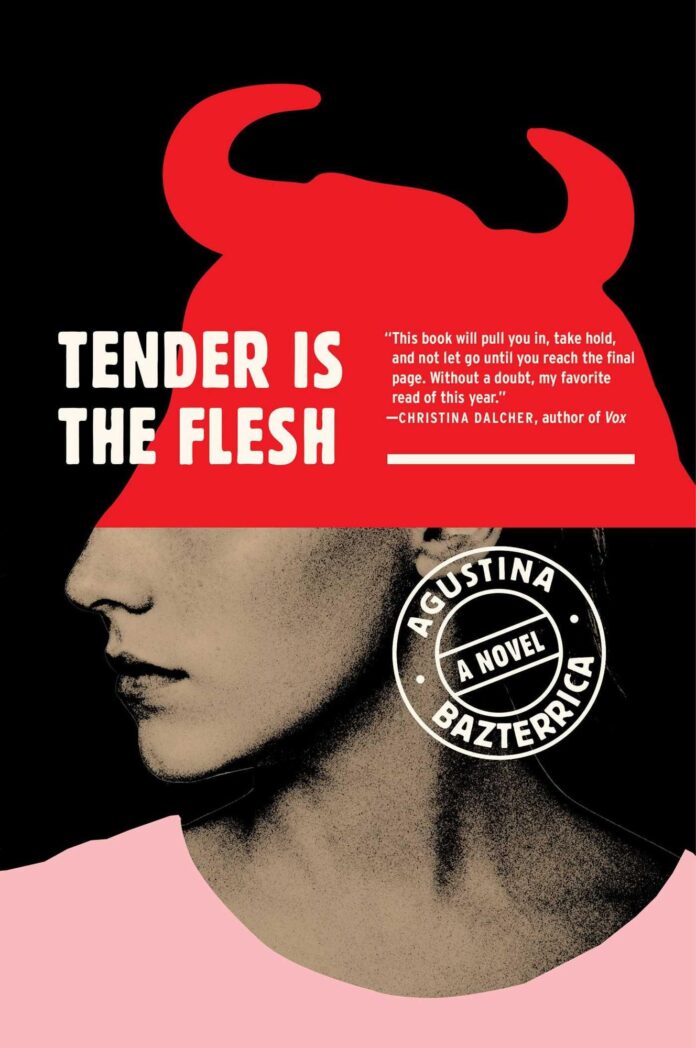In a world increasingly fascinated by the boundaries of morality and the essence of what it means to be human, Tender Is the Flesh emerges as a provocative exploration that challenges our perceptions of ethics, identity, and the human condition. Written by the Argentine author Agustina Bazterrica, this unsettling novel invites readers into a chilling dystopia where the line between humanity and monstrosity blurs, prompting a visceral reflection on society’s darkest impulses. Through a narrative steeped in both horror and introspection, bazterrica crafts a chilling tale that forces us to confront the limits of empathy and the tenuous nature of civilization itself.In this review, we delve into the intricacies of her haunting story, examining its themes and implications while considering its unsettling relevance in today’s world.
The Gripping Premise: A Dystopian World where Humanity’s Ethics are Redefined

In a world where the lines between humanity and monstrosity blur, the narrative thrusts readers into a chilling reality where nourishment comes at a grave ethical cost.The story’s architecture is meticulously crafted, challenging us to confront unsettling truths. The protagonist navigates a society that commodifies flesh, leading to a profound re-evaluation of morality and identity. This striking change in societal norms showcases how circumstances can compel individuals to question their long-held beliefs. It pushes the envelope on what it means to be human, forcing us to explore uncomfortable questions about survival and complicity.
The unsettling premise unfolds through a carefully woven tapestry of characters and themes that highlight the fragility of our ethical frameworks. As societal structures crumble, readers are invited to contemplate the implications of a world governed by stark survivalism. Key elements include:
- Desensitization to violence and exploitation
- Redistribution of power and privilege
- The fragility of empathy in dire circumstances
By delving into the undercurrents of this dystopian setting, the narrative not only serves as a mirror to contemporary issues but also challenges readers to examine their own beliefs. Through the eyes of individuals wrestling wiht their choices, the story highlights the paradox of sanctity amidst savagery, illustrating how easily the human spirit can be manipulated in the face of an otherwise inescapable predicament.
Characters as Mirrors: Exploring the Depths of Humanity through Disturbing Personas

In Tender Is the Flesh, the author intricately crafts characters that serve as unsettling mirrors to our own societal constructs and moral boundaries. Through the eyes of the protagonist, we are drawn into a chilling world where humanity’s darkest impulses are laid bare.Each character embodies a spectrum of human experience and emotion, reflecting the frailty of ethical principles when confronted with survival instincts. The protagonist’s journey through desensitization and complicity challenges readers to confront the profound moral dilemmas that arise when societal norms are stripped away, inviting us to question:
- What defines our humanity?
- How far would we go to preserve our own lives?
- Are we capable of empathy in the face of horror?
This exploration of disturbing personas highlights the unsettling nature of self-reflection in extreme circumstances. The supporting characters further complicate the narrative, each presenting unique perspectives on dehumanization and complicity. As we delve deeper into their choices and circumstances, we recognize the uncomfortable truths about our own interactions with society’s moral fabric. The characters are not mere vessels of horror; they are poignant reminders of the potential within us to both create and destroy, urging us to examine the thin line that often separates civility from savagery. To illustrate this complex interplay,the following table encapsulates key character traits and their symbolic implications:
| Character | Trait | Symbolism |
|---|---|---|
| Protagonist | Desensitized | Survival vs. Humanity |
| Secondary Character | Manipulative | Power Dynamics |
| Antagonist | Cold | Embodiment of Horror |
Narrative Style: Unraveling the Impact of Prose in Shaping Reader Perception

The narrative style in Tender Is the Flesh is a masterclass in immersive prose, drawing readers into a world where ethical boundaries blur and humanity is fetishized in a chillingly normalized fashion. The author’s choice of language—clinical yet poignantly evocative—creates a juxtaposition that both fascinates and horrifies. Through the protagonist’s eyes, we witness the dissonance between society’s veneer of normalcy and the grotesque undertones of cannibalism that underpin daily life. This stylistic approach does not merely serve as a vehicle for horror; rather, it carefully constructs a framework that compels the reader to reflect on the moral implications of commodifying human life.
As readers traverse the grim landscape of this fictional universe, the prose evokes a visceral reaction that can lead to a profound confrontation with one’s own ethical compass. The author employs vivid imagery and stark contrasts that invite readers to ponder questions such as:
- What does it mean to dehumanize others?
- How does society justify immoral actions under the guise of survival?
- In what ways do we unwittingly participate in the objectification of humanity?
This narrative style serves not only as a reflection of the story’s chilling realities but also transforms the act of reading into a psychological exploration, challenging us to face the ambiguous depths of our humanity. The seamless blend of profound themes and engaging prose ensures that the reader’s perception is not just shaped; it is fundamentally altered, leaving an indelible mark that resonates long after the final page.
Themes of Dehumanization: Analyzing the Philosophical Implications of Cannibalism

The unsettling narrative of Tender Is the Flesh deftly illustrates the profound implications of dehumanization that echo throughout its depiction of a society that commodifies human life. In this dystopian world, the distinction between human and animal erodes, revealing the fragility of ethical boundaries. By reducing individuals to mere resources, the text provokes a philosophical inquiry into the nature of humanity itself. What is the essence of being human if we can strip it away so easily? This question underscores the emotional dissonance experienced by characters who grapple with their own complicity in this grotesque reality. As the lines blur between society’s norms and grotesque realities, readers are compelled to interrogate the moral frameworks that sustain such atrocities.
This exploration of dehumanization inevitably extends to broader philosophical themes,offering a canvas for examining the nature of existence and identity.The characters’ struggles prompt reflections on the human condition and suggest that survival often comes at the cost of our humanity. The narrative masterfully employs cannibalism as a metaphor, forcing audiences to confront uncomfortable truths about power dynamics, objectification, and ethical desensitization. As an unsettling commentary on societal structures,the story invites contemplation on whether the monstrosities depicted are an extreme representation of our latent instincts or a tangible manifestation of future possibilities. Ultimately, ‘Tender Is the Flesh’ holds a mirror to humanity’s darkest impulses, challenging readers to reconsider the delicate balance between civilization and savagery.
Emotional Resonance: How Relationships are Altered in a Twisted Society

The narrative thrust of ‘Tender Is the Flesh’ reveals how deep-rooted emotional connections can be warped in a society that normalizes the grotesque. The characters, stripped of their humanity, navigate relationships that are stunted and dysfunctional, reflecting a world where empathy is viewed as a liability. In this twisted landscape, love and affection devolve into mere survival mechanisms, leaving individuals grappling with their primal instincts. The stark contrast between the societal acceptance of brutality and the characters’ lingering emotional needs creates a haunting paradox. Key themes that illustrate this emotional distortion include:
- Isolation: The characters often experience profound loneliness, struggling to find genuine connections amidst the pervasive moral decay.
- Dependency: Relationships become transactional, underscored by survival rather than emotional fulfillment.
- Complicity: Characters grapple with their roles in the societal structures that dictate their relationships,leading to internal conflicts and ethical dilemmas.
Moreover, the reshaping of relationships in this narrative serves as a commentary on the fragility of societal norms. The emotional resonance—or lack thereof—affects interactions profoundly, ultimately redefining affection as a commodity rather than an intrinsic human experience. The chilling portrayal of familial bonds twisted by necessity emphasizes this impactful transformation. An illustrative breakdown of relationship dynamics can be seen in the following table:
| relationship Type | Nature of Connection | Impact on Emotional Health |
|---|---|---|
| familial | Transactional and utilitarian | Heightened anxiety and guilt |
| Friendships | Shallow and opportunistic | Lack of trust and support |
| Romantic | Based on necessity | Emotional disconnection |
Critical Reflections: The Book’s Relevance to Contemporary Ethical Dilemmas

In a world increasingly fraught with technological advancements and ethical ambiguity, the themes explored in “Tender Is the Flesh” resonate profoundly with contemporary concerns. The novel grapples with the commodification of life and the moral implications of human exploitation, challenging readers to confront uncomfortable truths about their own societal structures. The concept of viewing individuals as mere products can be drawn parallel to modern-day issues such as:
- Factory farming practices that dehumanize animals
- Human trafficking as an ongoing global crisis
- Biotechnology and genetic manipulation that raise ethical questions
- Consumerism that turns individuals into data points
The book’s chilling narrative serves as a dark mirror reflecting our current ethical dilemmas. It forces us to evaluate our complicity in systems of oppression and commodification, pushing the boundaries of what we consider acceptable in our quest for progress. By examining the precarious line between humanity and monstrosity, the narrative becomes a call to action for readers to reconsider their roles in:
| Issue | Parallel in ‘Tender Is the Flesh’ |
|---|---|
| Ethics of Consumption | Dehumanization of livestock |
| human Rights Violations | Exploitation of ‘meat’ humans |
| Surveillance Culture | Monitoring of ‘products’ |
Visual Imagery: The Role of Vivid Descriptions in Evoking Strong Reactions

In the haunting world of “Tender Is the Flesh,” vivid descriptions become the lens through which the reader experiences the unsettling reality of a society that has desensitized itself to horror. The author meticulously crafts imagery that plucks at the strings of our emotions,forcing us to confront our own humanity,or lack thereof. A well-placed phrase can transform a scene into a visceral experience, allowing the reader to visualize the grotesque normalization of cannibalism with striking clarity. As an example, scenes depicting the surgical precision with which human flesh is processed invoke discomfort and challenge our perceptions of morality, blurring the lines between survival and savagery.
Through exquisite detail, the narrative transforms abstract concepts into tangible sensations, stirring a visceral reaction.Consider the stark contrasts presented throughout the text: the elegance of the dining experience versus the squalor of its origin. Each description serves to amplify the underlying themes of commodification and the fragility of ethical boundaries. this intentional use of visual imagery compels readers to experience a spectrum of emotions, from revulsion to a morbid curiosity, ultimately resulting in a profound reflection on societal values. The psychological impact of such imagery not only captivates the audience but also enhances the text’s unsettling examination of what it truly means to be human in a world stripped of empathy.
Reader Engagement: provoking Thought and dialogue on Morality and Humanity

In “Tender Is the Flesh,” Argentine author Augustina Bazterrica invites readers into a disturbing yet thought-provoking world where humanity’s moral compass is not only tested but completely redefined. By presenting a society that has normalized the consumption of human flesh, the narrative challenges us to reflect on ethical boundaries and the consequences of dehumanization. It raises pivotal questions about the essence of humanity and what it means to be ethical in a world stripped of compassion. The chilling premise not only makes us confront the limits of societal norms but also forces us to ponder our own values, particularly in the face of survival and sustenance.
This novel encourages dialogue about consumerism, exploitation, and the fragility of human rights, leading us to examine our roles as both individuals and members of society. As characters navigate a morally bankrupt landscape, readers are prompted to consider the implications of their own choices, further igniting discussions around personal obligation and the fate of ethics in a dystopian future. By delving into the dark intersections of morality and survival, “Tender Is the Flesh” serves as a stark reminder of the potential depths of humanity—be they heinous or heroic. The stories we tell and the decisions we make ultimately shape our reality, prompting a collective introspection on the very essence of what it means to be human.
Artistic Interpretation: Evaluating Cover Art and Design Choices in Context

Cover art and design play a crucial role in shaping the reader’s initial impression of a book, particularly one as provocative as ’Tender Is the Flesh’. The choice of imagery—often unsettling yet compelling—mirrors the book’s exploration of humanity’s boundaries and ethical dilemmas. The cover typically features stark, minimalist design elements that draw attention to the thematic undercurrents of dehumanization and consumption.The color palette, often muted or monochromatic, enhances the somber tone of the narrative.This deliberate choice sets the stage for readers, encouraging a deeper reflection on the darker aspects of human nature.
In the realm of cover typography, the font selections tend to be bold yet simplistic, embodying a sense of urgency and bleakness that aligns with the story’s core message. Typography choices can affect a reader’s perception and emotional engagement, thus the straightforward yet impactful lettering invites readers to confront the uncomfortable truths within the text. To better understand these design choices, consider the following aspects:
| Design Element | Impact on Theme |
|---|---|
| Imagery | Reflects dehumanization |
| Color Palette | Evokes somber feelings |
| Typography | Conveys urgency |
Cultural Commentary: insights into Society’s Views on Consumption and Control

The narrative of Tender Is the Flesh serves as a haunting mirror reflecting society’s troubling tendencies towards consumption and control. In a dystopian world where humans become livestock, we are forced to reckon with the moral implications of our modern consumption habits. This intense backdrop raises questions about the commodification of life and humanity’s desperate urge to dominate nature for its own ends. As readers,we are invited to explore societal norms that prioritize efficiency and productivity,often at the cost of ethical considerations. This forced normalization of viewing sentience as mere capital challenges us to confront our appetite for convenience, prompting a reevaluation of what it means to be humane in a culture increasingly defined by utilitarianism.
| Consumption Factors | Societal Reflections |
|---|---|
| Meat Consumption | Normalizes violence and detachment from the source of sustenance. |
| Technological Control | Allows for manipulation and surveillance, exacerbating power dynamics. |
| Luxury Goods | Perpetuates inequality and fosters a culture of elitism. |
| Media Representation | Shapes perceptions of acceptable consumption and influences desires. |
Moreover, the psychological dimensions of control manifest through the protagonist’s internal conflicts, highlighting an unsettling reality where the oppressed become complicit in their subjugation. This mirrors contemporary debates on consumer culture, where individuals often surrender agency in favor of trends and societal expectations. As the line between consumer and consumed blurs, we are led to question the ethical underpinnings of our choices and the sacrifices made at the altar of convenience. The chilling day-to-day normalization of such attitudes in the novel serves as a cautionary tale, urging reflections on how far we are willing to go in the name of progress and comfort.
Philosophical Underpinnings: Examining Existential Questions Embedded in the Story

At its core, the narrative invites readers to wrestle with profound existential questions about morality, identity, and the nature of humanity. In a dystopian world where humans are commodified, the text becomes a brutal examination of what it means to be ‘human’.The stark choice to consume human flesh blurs the lines between predator and prey, challenging us to reconsider our notions of empathy and the sacredness of life. Characters oscillate between the mundane and the monstrous, which forces a confrontation with inherent contradictions in human behavior—our capacity for both love and violence. Here, key themes emerge:
- Objectification of humanity: How does one reconcile the act of dehumanization with their moral compass?
- the search for meaning: In a world stripped of its ethical foundations, how do individuals navigate their own existence?
- The nature of choice: Are the characters’ decisions freely made, or are they the products of their environment?
laced throughout the story are symbols that resonate deeply with philosophical reflections on existentialism. The stark imagery reflects a society weary of its conscience, where the commodification of life raises unsettling queries about societal values and ethical dilemmas. As the characters grapple with their roles within this oppressive system,they embody a universal struggle against absurdity—echoing the thoughts of existential philosophers like Camus and Sartre. This layering of rich symbolism can be encapsulated in the following table:
| symbol | Meaning |
|---|---|
| Flesh | life’s fragility and the ethics of consumption |
| Hunger | The insatiable desire for connection and purpose |
| Processing Plant | Dehumanization and loss of individuality |
Exploring the Author: A Look into the Mind Behind ‘Tender Is the Flesh’ and Their Inspirations

In delving into the complexities of Tender Is the Flesh, one finds a profound commentary on the human condition juxtaposed with the grotesque. The author, whose personal experiences and keen observations of societal norms shine through, deftly navigates themes of commodification and desensitization. Drawing inspiration from a variety of sources, including dystopian literature, philosophical discourses on humanity, and real-world issues related to ethics in consumption, the narrative challenges readers to confront their own moral boundaries and the ramifications of a world stripped of compassion. This hauntingly vivid exploration serves as a reflection of our current realities, where the line between civilization and barbarism becomes increasingly blurred.
Among the key influences that permeate the text are:
- Contemporary Social Issues: Observations of factory farming and societal detachment.
- Literary Classics: Homages to authors like Kafka and Orwell, whose works grapple with existential dread.
- Ethical Beliefs: Discussing the moral implications of consumption and ownership.
Moreover, the author uses symbolism and surrealism to enhance the unsettling atmosphere of the narrative, compelling readers to re-evaluate their perspectives on humanity. In an age where technology meets primal instincts, this narrative serves not only as a cautionary tale but also as a mirror reflecting the darkest corners of our collective psyche.
Closing Remarks
As we close the chapter on our exploration of “Tender Is the Flesh,” we find ourselves not only reflecting on the narrative’s haunting portrayals but also grappling with the profound questions it raises about humanity,ethics,and our relationship with the world around us. This novel, while unsettling in its delivery, serves as a compelling mirror, forcing us to confront the uncomfortable realities of what it means to be human in a society where the lines between compassion and exploitation blur.
In its chilling examination of human nature, the story pushes boundaries, urging readers to question their own values and assumptions. As we step away from the intricate web of characters and the dystopian world they inhabit, we leave with a lasting impression—an echo of the unsettling truths that linger long after the final page is turned.“Tender Is the Flesh” is more than just a story; it is a catalyst for reflection, challenging us to ponder the true limits of humanity.In its dark depths, we find not only discomfort but also an prospect for deeper understanding, inviting us to carry these lessons far beyond the confines of fiction.












